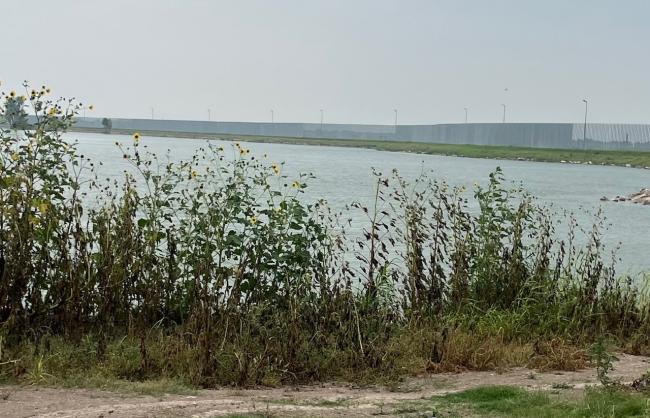
This review is a collaboration between NACLA and The Border Chronicle.
The Border Patrol agent walked down the slope to where I was packing up my tent and asked if I had seen anyone go through. We were on the U.S. side of the Rio Grande near Mission, Texas, where I had been camping the last few nights. From where I stood, I could see Mexico across the swiftly flowing river, where a single sabal palm tree stood amid a thicket along the riverbank.
I told him no, I had seen nobody. He said there were footprints. “I’ve been walking around,” I said. “Maybe it was me?” He asked, “Were you barefoot?” and pointed to the ground.
“No,” I said. I hadn’t walked around barefoot. But as we stood there in a moment of utmost seriousness, pondering this potential breach of the U.S.-Mexico border, another thought came to mind: Who cares? I had just read The Case for Open Borders, by John Washington, perhaps one of the most important books to drop into the overheating 2024 election cycle—which, as we all know, is keeping the border front and center. Dropping a book into this melee with the stigmatized term “open borders” is significant because it helps Washington pry apart the dominant political narratives around migration. And it accomplishes just that. Moreover, The Case for Open Borders is eloquently written and packed with arguments and examples in the United States and beyond, reframing the issue in a way that undermines the familiar, tedious border bluster. If you hunger for new visions, new ways of doing things, and understand that the current situation is not inevitable, or even desirable, this book is for you.
I did not say “who cares” out loud to the agent, though Washington’s book would have helped me say it authoritatively. Camping out on the Rio Grande was like watching a constant militarized flotilla of gunboats: the Border Patrol, the state police, the Coast Guard. Their nerve-fraying patrols were constant, day and night. This was coupled with loud helicopters flying overhead with their growling propellers and motors. All around were the border walls, built by the federal government and the donor-funded organization We Build the Wall. The Rio Grande is an otherwise gorgeous river with a plethora of singing birds—along with herons, ducks, and egrets. I was just down the road from the National Butterfly Center.
Washington dedicates a chapter to an environmental argument for opening the border. It’s an urgent case, he argues, because millions of people are already on the move because of climate catastrophe, and there will be millions more soon, amid what is predicted to be an “unprecedented population upheaval.” Given the scientific consensus that the world will inevitably see rising sea levels and suffer more catastrophic floods, droughts, and storms, the last thing we need is more border enforcement, with its inherent violence. “As we begin to see the greatest wave of global migration the world has ever experienced,” he writes, “we must recognize that the crisis is already upon us, that we must act with humanity, and that we must open the borders.”
Washington writes about the same destruction I saw on the banks of the Rio Grande: the heavy-handed border apparatus that destroys ecosystems and imperils wildlife. One of the finest examples of border subversion I witnessed while camping was how the birds kept singing and flying back and forth across the river, patrol boats or not.
The environmental argument is central to The Case for Open Borders, but Washington also offers a political argument, an economic argument, and a historical argument. You can also skip right to the end, where he summarizes everything in a list of 21 arguments for open borders, a list I would advise people read to prepare for those contentious family dinners many of us will have as the elections approach. In the economic argument, Washington tears down just about every facile myth that follows the migration story, arguing instead that open borders are “economically smart.” Listening to the omnipresent election narratives, no one would ever think that migrants boost GDP and contribute tax money (often a lot of it) to local, state, and federal governments. “Tearing apart families is not sound economic policy,” he writes. I should have said that to the agent.

One the most central and poignant observations in The Case for Open Borders is that “with massive spending on the military and border militarization and huge payouts to defense and police budgets around the world, nations across the globe are trading the welfare state for a police and border state.” I couldn’t agree more. After all, while camping, I witnessed the expensive border apparatus pass me by—$29.8 billion to the federal Customs and Border Patrol (CBP) and U.S. Immigration and Customs Enforcement (ICE) in 2023, $11 billion to Texas’s Operation Lone Star since 2021. During the day, meanwhile, I interviewed people in the region about an alarming water crisis that is leaving farmers unable to irrigate their crops. Washington writes, correctly, “The rich, not immigrants, are the problem.” I would have loved more on this point, particularly on the multinational corporate policy of open borders (often called free trade agreements) and the subsequent plunder of natural wealth in now-migrating communities around the globe. Corporate executives have the luxury of flying over borders at 35,000 feet, and they never have to worry about ICE on their tail to arrest, incarcerate, and deport them.
Perhaps the real crimes lie in this type of corporate migration, not among migrant communities. Washington easily debunks the immigrant/crime narrative and effortlessly backs his positions with endless data from decades of reports, which clearly establish that there is less crime in neighborhoods where undocumented people live.
It is not the migrant communities that are dangerous, Washington writes, it’s the border itself. “The most convincing case” for open borders is that “borders kill.” One night along the Rio Grande, at about 1 a.m., I sat out on the picnic table to watch the river and write some notes. As I scribbled, I heard the growling motor of a patrol boat. I looked downriver and saw a boat zigzagging from one side to the other, making huge waves. The scene had the frenetic energy of teenagers doing doughnuts in an icy parking lot. Since the patrols were all heavily armed, it seemed dangerous, verging on violent.
If they see me, I thought, a mere shadow on the riverbank, will they shoot? While I knew this was unlikely, the threat of violence is so much a part of the border that I backed into my tent, waiting in silence until the patrol passed. Later, while talking to the agent about the footprints, I wondered if the boat had done this because they saw people trying to cross. It reminded me of helicopters descending on groups crossing in Arizona, their propellers lifting up dust, terrorizing the group and causing them to run in all directions—sometimes to injury and sometimes to getting completely lost and sometimes to death.
On the border there has been plenty of death; in 2023, there were 179 deaths along the Arizona-Mexico border, according to the group Humane Borders. Given how desolate the territory is, many human remains are never recovered. And 2023 was the deadliest year on record across the globe for migrants, including people crossing the Rio Grande.
I thought about the barefoot person who had left tracks outside my tent. Had that person been crossing in the night, risking their life? Did that person deserve to be treated like a criminal? “Something essential about borders,” Washington writes, is “that the border itself generates transgression.” No border, no crime. And no border, no death.
Which brings me to the historical argument in The Case for Open Borders: “Where does the authority to draw or enforce a border come from?” Washington asks in the first line of the chapter. In the case of the Rio Grande, the boundary was drawn after a war in which the United States took over nearly half of Mexico, while trampling, massacring, and displacing Indigenous people who were already living there. If we take the raw violence of boundary building, as so thoroughly described in this chapter, to be part of a settler colonialism that disparaged, destroyed, and displaced huge swaths of populations, the border itself can be seen as an act of war and a historic injustice.
Washington describes “the infamous Trail of Tears” as an act of “mass deportation and murder.” Certainly, this is how we can see the border in a new way; it’s always been about displacing and separating people. Its origin is violence, and to stand on the banks of the Rio Grande or in the deserts of Arizona is to witness this colonial brutality in perpetuity. Borders “are inflicted, not natural,” Washington writes. “They are weaponized tools, not inherent edges. Borders are as mobile—and as vulnerable—as human beings.”
I wanted to tell that agent, Who the fuck cares? Why not let people go where they want to go? Why couldn’t we, as The Case for Open Borders suggests, take some incremental steps to a place where a person wouldn’t have to risk their life crossing a rapid river, and then walking barefoot on sharp gravel on the other side? Why couldn’t the United States begin what Silky Shah—executive director of Detention Watch Network and author of the forthcoming Unbuild Walls: Why Immigrant Justice Needs Abolition—told Washington: begin with infrastructure reduction? Maybe there is no need for the heavily armed patrol boats constantly drowning out the birds on this river. Maybe all the walls and surveillance tech, all that money, could be used for something much more useful. Writing from the banks of the Rio Grande, I am convinced that another world is indeed possible and attainable—a beautiful notion that is at the heart of The Case for Open Borders. And we can start walking in that direction right now.
Todd Miller writes a weekly post for The Border Chronicle and has authored four books, the most recent being Build Bridges, Not Walls: A Journey to a World Without Borders. He is based in Tucson, Arizona.

